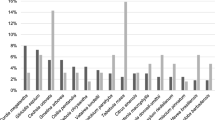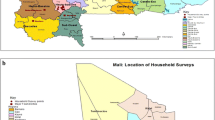Abstract
The Socioeconomic Impact of Truffle Cultivation in Rural Spain. Commercial black truffle (Tuber melanosporum) plantations have been promoted in Europe with the intention of benefiting rural economies while conserving biodiversity through the expansion of oak woodlands. In this context, a socioeconomic study was conducted around the town of Sarrión in eastern Spain, where government subsidies have supported oak reforestation and truffle cultivation in unproductive hilly areas since 1987. Currently there are about 4,500 ha of truffle orchards in the surrounding county and 530 members in the local truffle association, which has provided a key forum for truffle cultivators to share technical, financial and administrative experiences. Structured interviews were carried out in 2002 with a number of orchard owners, as well as representatives of financial and governmental institutions. Truffles, which are harvested using trained dogs, typically fetch local cultivators average prices of 220–670 EUR/kg, although retail prices of high-quality specimens may reach twice this amount. In addition to the direct economic impact, an increase in local land prices was also documented, as well as a tendency for continued expansion of truffle orchards, and thus oak reforestation. In conclusion, the promotion of truffle cultivation through autonomous community and provincial government subsidies, in conjunction with support by local banks, a dedicated local truffle association, and growing interest on behalf of local farmers, seems to have achieved the mutual goals of biodiversity conservation and improving the rural economy in this region of Spain.
Resumen
Impacto Socioeconómico del Cultivo de la Trufa en España. Las plantaciones orientadas hacia la producción de trufa negra (Tuber melanosporum) se impulsaron en Europa con el objetivo de favorecer las economías rurales, así como de conservar la biodiversidad a través de la expansión de los encinares. Dentro de este contexto, se llevó a cabo un estudio socioeconómico en la zona del municipio de Sarrión y su contorno localizada en el la parte oriental de España, donde existen subvenciones para la reforestación y el cultivo de la trufa desde el año 1987. En la zona estudiada, actualmente hay alrededor de 4.500 ha de plantaciones de trufa, además de una asociación de cultivadores de trufa con 530 miembros, la cual sirve de plataforma para que sus socios compartan experiencias técnicas, financieras y administrativas. En el año 2002 se llevaron a cabo entrevistas a propietarios de plantaciones, así como a los representantes de instituciones financieras y gubernamentales. Las trufas, que son recolectadas con perros adiestrados, generalmente son vendidas por los propios cultivadores a precios que oscilan entre los 220–670 EUR/kg, aunque en la venta al detalle, el precio de las trufas de alta calidad puede doblar dichas cantidades. Además del impacto económico, también observamos un incremento en el precio del suelo rústico, así como la expansión continuada de plantaciones de trufa y de reforestación. En conclusión, el progreso del cultivo de la trufa a través de las subvenciones de la Comunidad Autónoma y la Diputación Provincial, con la colaboración de los bancos locales, una comprometida asociación de cultivadores de trufa y un creciente interés por parte de los agricultores locales, parece que ha alcanzado los objetivos comunes de biodiversidad y conservación junto con la mejora de la economía de esta región de España.

Similar content being viewed by others
Literature Cited
Bencivenga, M. and G. di Massimo. 2000. Risultati Produttivi di Tartufai Coltivade di Tuber melanosporum Vittad. in Umbria. Micologia Italiana 2:38–44.
Callot, G. 1999. La Truffe, la Terre, la Vie. Institut National de la Recherche Agronomique, Paris, France.
Chevalier, G. and J. Grente. 1979. Application Pratique de la Symbiose Ectomycorhizienne: Production a Grande Echelle de Plants Mycorhizes par la Truffe (Tuber melanosporum Vittad.). Mushroom Science 102:483–505.
Departamento de Agricultura de la Diputación Aragón. 2000. Anuario Estadístico Agrario. Gobierno de Aragón, Zaragoza, Spain.
Estrada, J. M. and Alcántara, C. 1990. La Tòfona. Departament d’Agricultura, Ramaderia i Pesca, Generalitat de Catalunya. Barcelona, Spain.
García, S., S. Reyna, R. Pérez, and J. A. Rodriguez. 2007. Ecología de la Trufa y las Áreas Truferas. In S. Reyna, ed., Truficultura. Fundamentos y Técnicas. Ediciones Mundi-Prensa, Madrid, Spain.
Gärdenfors, U. 1994. Eken—Utnyttjad av Tusentals Organismer. Pages 77–82 in U. Olsson, ed., Ekfrämjandet 50 år. Ekfrämjandet och Skogsvårdsstyrelsen, Ronneby, Sweden.
Giovannetti, G., N. Roth-Bejerano, E. Zanini, and V. Kagan-Zur. 1994. Truffles and Their Cultivation. Horticultural Reviews 16:71–107.
Hall, I., G. Brown, and J. Byars. 1994. The Black Truffle. 2nd Ed. New Zealand Institute for Crop and Food Research, Christchurch, New Zealand.
Instituto Nacional de Estadística. 2004. Encuesta de Población Activa. Instituto Nacional de Estadística, Madrid, Spain.
Instituto Nacional de Meteorologia. 2002. Aragon, La Rioja y Navarra. Instituto Nacional de Meteorología, Madrid.
Lefevre, C. and I. R. Hall. 2001. The Status of Truffle Cultivation: A Global Perspective. Acta Horticulturae 556:513–520.
New Zealand Truffle Association. 2001. Newsletter 26, 3.
Oliach, D., J. A. Bonet, C. R Fischer, A. Olivera, J. Martínez de Aragón, L. M. Suz, and C. Colinas. 2005. Guía Técnica para el Cultivo de la Trufa Negra (Tuber melanosprum Vitt.). Centre Tecnològic Forestal de Catalunya, Solsona, Spain.
Olivier, J. M. and L. J. L. D. van Griensven. 2000. Progress in the Cultivation of Truffles. Science and Cultivation of Edible Fungi. Proceedings of the 15th International Congress on the Science and Cultivation of Edible Fungi, Maastricht, Netherlands, 15–19 May 2000: 937–942.
_____, J. C. Savignac, and P. Sourzat. 2002. Truffe et Trufficulture. Editions Fanlac, Périgueux, France.
Pacioni, G. 1991. Effects of Tuber Metabolites on the Rhizospheric Environment. Mycological Research 95:1355–1358.
Pegler, D. N., B. M. Spooner, and T. W. K. Young. 1993. British Truffles: A Revision of British Hypogeous Fungi. Royal Botanic Gardens, Kew, U.K.
Reyna, S. 2007. Sostenibilidad de la Truficultura: Aspectos Ecológicos, Económicos y Sociales. In S. Reyna, ed., Truficultura. Fundamentos y Técnicas. Ediciones Mundi-Prensa, Madrid, Spain.
Riousset, L., G. Riousset, G. Chevalier, and M. C. Bardet. 2001. Truffes d’Europe et de Chine. INRA, Paris, France.
Rocchia, J. M. 1992. Des Truffes en Général et de la Rabasse en Particulier. Èditions A. Barthélemy, Avignon, France.
Samils, N. 2002. The Socioeconomic Impact of Truffle Cultivation in Rural Spain. M.Sc. thesis. Department of Forest Mycology and Pathology, Swedish University of Agricultural Sciences, Uppsala, Sweden.
Sarrión City Council. 2002. Sarrión City Council, Plaza de España, 1; E-44460 Sarrión (Teruel), Spain.
Secretaría General Técnica del MAPA. 2005. Encuesta de Precios de la Tierra 2004. Subdirección General de Estadísticas Agroalimentarias. Ministerio de Agricultura Pesca y Alimentación, Madrid. Spain.
Trappe, J. M. 1988. Use of Truffles and False-Truffles around the World. Pages 19–30 in M. Bencivenga and B. Granetti, eds., Atti del II Congresso Internationale sul Tartufo, Spoleto, Italy.
Wedén, C. and E. Danell. 1998. Sommartryffel, Tuber aestivum, och Andra Tryfflar i Sverige. Svensk Botanisk Tidskrift 92:65–80.
_____, L. Ericsson, and E. Danell. 2001. Tryffelnyheter från Gotland. Svensk Botanisk Tidskrift 95:205–211.
Acknowledgments
We wish to thank Mari Carme Vergés for invaluable support during fieldwork, Pablo Sebastián, secretary of Asociacion de truficultores y recolectores de trufa de la provincia de Teruel (the local truffle association of Sarrión), who made this study possible by his generous cooperation, and David Arora and Glenn Shepard, Jr., for their helpful suggestions to improve the manuscript.
Author information
Authors and Affiliations
Corresponding author
Rights and permissions
About this article
Cite this article
Samils, N., Olivera, A., Danell, E. et al. The Socioeconomic Impact of Truffle Cultivation in Rural Spain1 . Econ Bot 62, 331–340 (2008). https://doi.org/10.1007/s12231-008-9030-y
Published:
Issue Date:
DOI: https://doi.org/10.1007/s12231-008-9030-y




